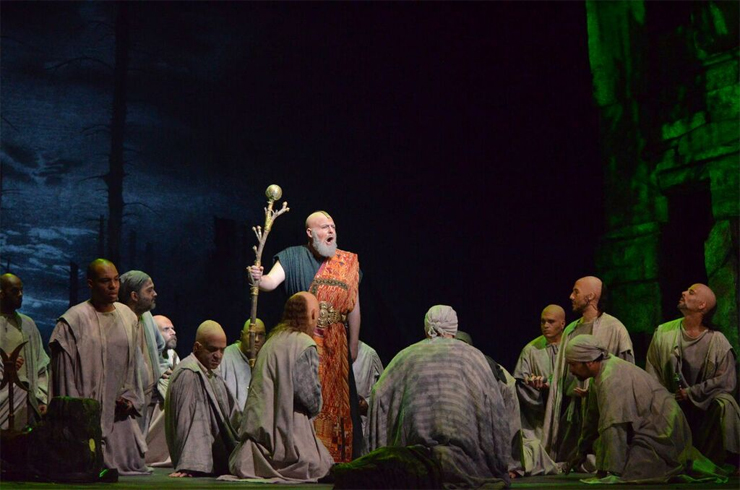
A good story is a good story, right? And when that story is centered on a wife’s calculated desire for revenge against her unfaithful husband that includes the murder of their children, you know it’s gonna grab the attention of audiences. No, it wasn’t Medea being presented at Miami’s Adrienne Arsht Center last Saturday night, it was Vincenzo Bellini’s Norma.
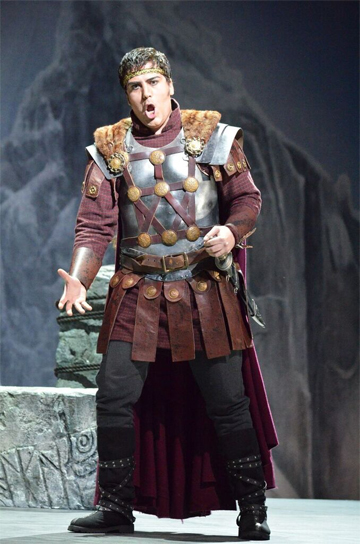
Norma has all the trappings of a Greek tragedy: human flaw, passion, rage, vengeance and grief. But no coincidence here. Norma is actually based on Medea, Euripides’ most enduring work.
Norma is a spectacular opera; it is a dramatic engine fueled by high octane music with long beautiful arching lines of bel canto.
When Florida Grand Opera decided to produce Bellini’s masterful work, they had to rely on a very small community of sopranos who could essay the role. Norma demands a voice muscle that can deliver both power and nuance while navigating a plethora of notes, and do this continuously up to and including its searing ending. FGO found two such divas in Mlada Khudoley and Mary Elizabeth Williams.
Khudoley, statuesque with flashing good looks, commanded the boards on opening night, Jan. 23, portraying the Druid High-priestess in Roman-occupied Gaul with a presence both saturated with emotion and restraint and pipes that were shattering and heartbreaking. Khudoley rendered Norma’s signature aria, “Casta diva,”evoking the moon and praying for peace, with the strength and softness required to make the long arching musical phrases ring broadly and delicately. She remained buoyant while reaching into her head voice and dropping seamlessly into her basement of low notes.
The aria was every bit bel canto (beautiful singing), gratifyingly unpacked by Khudoley. She rolled into her cabaletta, “Ah! bello a me ritorna,” realizing every note of the surplus of notes, hoping to have her enemy and lover Pollione return to her. Both delighted and disturbed by her two sons, she showed her dark insides as she delivered a passionate “Teneri, teneri figli, Essi, pur dianzi delizia mia” with an inner intensity that was palpable.
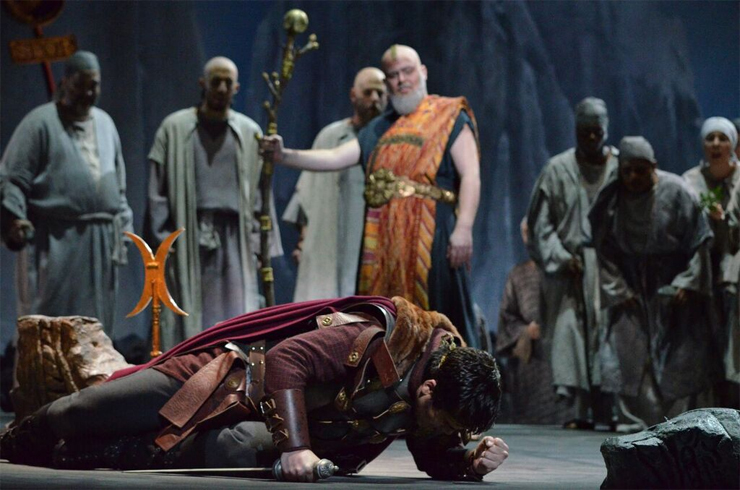
While most great operas rely on their arias to sell their productions, the duets are truly the draw for Norma.
Mezzo-soprano Dana Beth Miller, playing the young priestess Adalgisa, shared her conflicted soul (over taking her religious vows and also being in love with Pollione) with a generous voice that blended beautifully with Khudoley. Reminiscing over their parallel experiences of falling in love (unknowingly with the same man), their duet, “Sola, furtiva al tempio,” was rich with mutual enchantment and personal melancholy. Their voices were an exquisite match with a lovely woven a capella at the cleverly constructed duet’s conclusion. So that Adalgisa could be free to marry, Norma released her from her vows, “Ah! sì, fa core, abbracciami, Perdono e ti compiango,” Khudoley and Miller’s voices, after a few vocal volleys, twining together like a single vine wrapped around a single pole.
They teamed up later, Adalgisa imploring Norma to take pity on her children (“Mira, o Norma”), the pair sublimely combining their voices again as one, the bond between them tangible. They transitioned into “Si fino all'ore estreme, compagna tua m'avrai,” expressing their devotion to each other, their coiled voices continuing to scale the walls of the concert hall.

Giancarlo Monsalve, a tenor in tall, dark and handsome mode, brought Pollione (the Roman proconsul in Gaul) to life with a commanding stage presence and a voice that was just shy of powerful, though pleasing and pure. After ruminating on how he no longer loved Norma (who had broken her sacred vows for him and had borne his two children) and now loved the younger priestess Adalgisa, Monsalve managed well the leaps and the money note on the stirring “Meco all'altar di Venere,” relating a dream to his friend Flavio (a steady tenor Edgar Miguel Abreu) which foretold his demise. He confidently navigated “Me protegge, me difende,” signifying the power to overthrow his enemy. Monsalve played his bluster and swagger and later remorse with honesty.
Praying for protection from her love, Miller wrought “Sgombra è la sacra selva...Deh! proteggimi, o Dio!” with her huge mezzo, her deeply troubled demeanor consistent with the poignant vocals. She and Monsalve blended nicely (though at times she overpowered him) as he tried to convince her to join him in Rome (“Vieni in Roma”). Melody and tension combined in this duet, underscoring Adalgisa’s conflicted devotion to her religion and her love for Pollione, Bellini’s melodic music remaining in a heightened state.
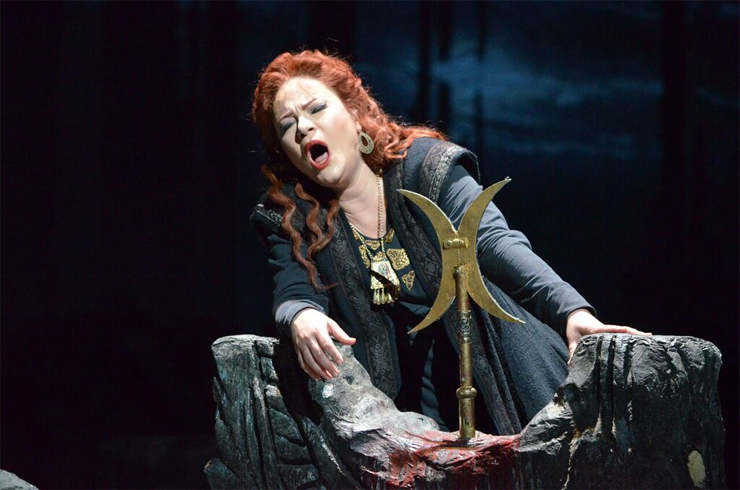
Photos: Brittany Mazzurco Muscato for Florida Grand Opera.
So, Adalgisa is in love with Pollione. That doesn’t work for Norma. She chews out Pollione for being "the wicked one," and a pair of trios between her, Adalgisa and Pollione heightened the drama. Khudoley, Miller and Monsalve, individually articulating the deception, horror and reproachment of their tortured triangle, blended their positions beautifully, Bellini’s choice of a waltz tempo almost belieing the gravity of the situation. The three voices were crafty, careful and certain in their own corners, the pace picking up steam with the next trio as each pitched their point,the trio growing in feeling and urgency along with the orchestra and audience at its conclusion.
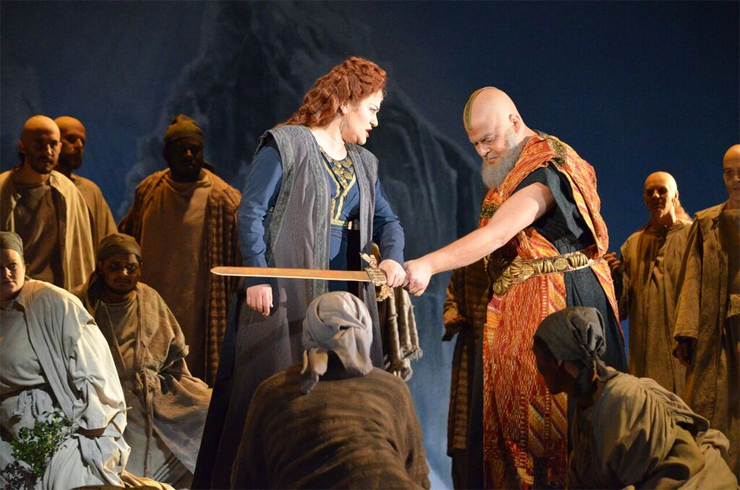
Perhaps the most engaging and core-gripping duet (“In mia man alfin tu sei”) came as Norma made demands on the captured and bound Pollione to spurn Adalgisa. Bellini’s sumptuous melody, suggestive of love gone wrong but love nonetheless, underscored Khudoley mining the romance out of the “at last you are in my hands” lyric. She delivered a salvo of riveting high notes astride the mounting music while a fraught Monsalve responded to her threats of killing their children and Adalgisa. They powerfully joined voices on “Già mi pasco ne' tuoi sguardi,” Norma taking pleasure in making him as miserable as she, Khudoley delivering her money note with an almost insane passion to conclude the cabaletta. Monsalve played his increasing desperation both physically and vocally on his knees, his pleas for sparing Adalgisa striking home convincingly.
Stage director Nic Muni intensified the drama with Khudoley clasping her hands and looking towards the heavens as she demanded that Pollione swear to shun Adalgisa, raising the stakes as she circled him like a predator to prey.
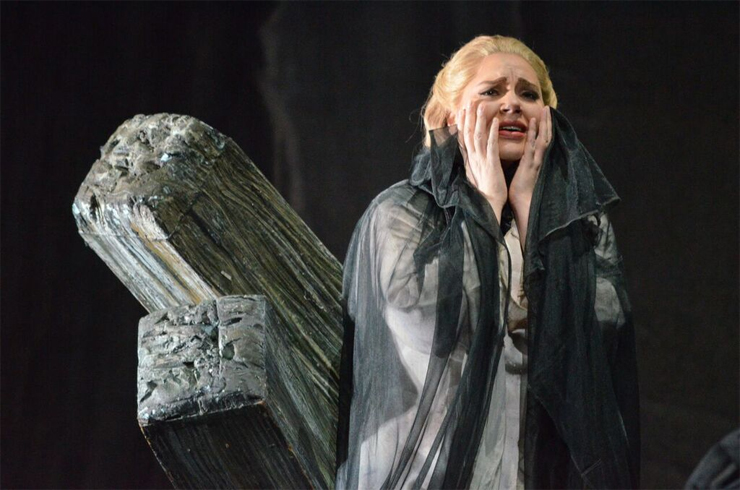
Another fine bit of Muni’s staging found Adalgisa on her knees with Norma behind her and a golden scythe gleaming in the light(which Adalgisa used to dispatch herself while no one was looking), setting the stage for Norma to out Adalgisa for betraying her vows. A soft tapping of the timpani, suggesting a collective heartbeat, underscored the exquisite “Qual cor tradisti,” Norma’s aria expressing to Pollione the heart he betrayed and lost. This cleared the way for the denouement – that it was she who broke her vows, slept with the enemy and borne his children. Monsalve joined Khudoley to duet the gorgeous and crushing melody, agreeing to join her and rekindle their love together in the funeral pyre, the ensemble then fusing deeply into the refrain, expressing their sorrow and anger as their pleas mounted with emotional heartbreak. (Never mind that Norma said to her pleading crowd, “Norma does not lie,” while lying for quite some time. But that’s a different story.)
If you were one of the few still missing a heart at this point, the final sublime ensemble chord with Khudoley soaring on top, gave you one.
Khudoley’s remarkable instrument remained strong and supple through the final scene as she pleaded on her knees to her father, Oroveso, to spare Norma’s children’s lives (“Deh! non volerli vittime”). Her big soaring notes combining with an undercurrent of strings suggested the specter to come, Oroveso and the ensemble swelling and exploding as Norma and Pollione faced the pyre.
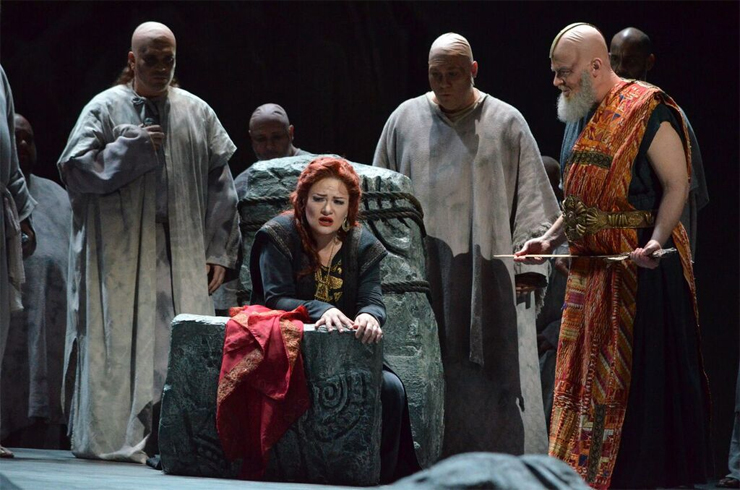
Playing Oroveso, Chief of the Druids, Basso Craig Colclough, slender and solid in appearance, served up "Norma il predisse, o Druidi," with rich deep pipes. (Wagner, a fan of Norma, wrote this properly bel canto aria into the opera 2 years after Bellini’s death to give a little more heft to the scene where Oroveso was encouraging the Druids to kick Roman butt.) Colclough was formidable, rejecting Norma’s potent pleas to spare her children, then yielded to her wishes with warmth and sensitivity.
Tall soprano Sarah Payne, playing Norma’s maid Clotilde, showed great dignity, was resolute and deeply concerned for Norma's best interests.
Maestro Anthony Barrese helmed a finely tuned FGO orchestra, adroitly conducting the nuance, foreboding and spectacle of Bellini’s entire score. Chorus master Katherine Kozak prepared a big tight and commanding FGO chorus for “Guerra, guerra!” ("War, war!").
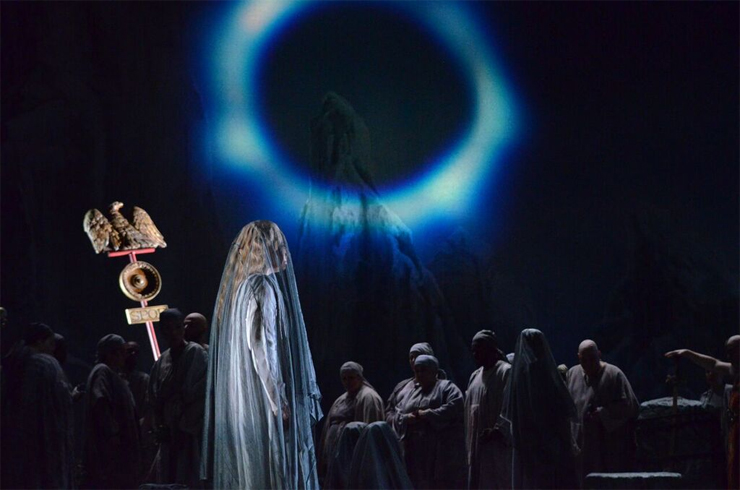
John Conklin’s set design included a raked platform in the center where much of the action took place, defined on the right and left by gigantic stone and timber walls –not unlike late Roman trash construction with virtually all recycled architectural bits crammed together. The painted drops in the back represented high quality stage paintings illuminating three gigantic granitic "horns”(like one might find in the Alps) and perhaps a solar eclipse at the opera’s conclusion.
Muni worked with Conklin to create a locale of very high and isolated altitude, where people might have easily hallucinated from the low oxygen. This, combined with the Druids apparent hunger strike at top of show, may account for the few who appeared to remain vaguely conscious at the time Norma and Pollione actually stepped into the pyre. The pyre was a bone heap which disquietingly appeared to contain some human remains.
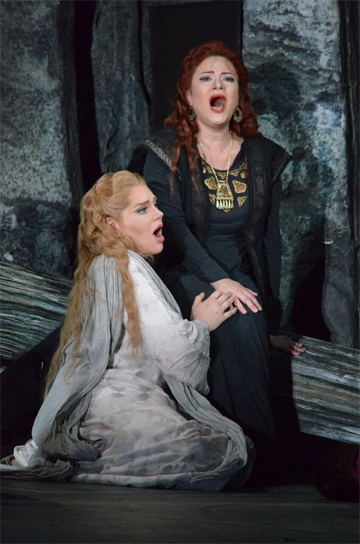
Thomas Hase lit the production with minimal color, saving its use for just a couple high intensity moments, most notably when the pyre began to glow bright red, and Norma and Pollione stepped onto it as a giant circle of red flame consumed them. Otherwise the stone facades were bathed in hard, clear light that supported the thin atmosphere environment.
The Druids wore rough costumes in various shades of gray reflecting their hard lives, while the Roman soldiers were decked out in their traditional armored fare. Wigs were nicely done, long red for Norma, long blond for Adalgisa which she cut off in a show of solidarity to Norma.
"Norma"
By Vincenzo Bellini; libretto by Felice Romani; conductor,Anthony Barrese; stage director, Nic Muni; production, Cincinnati Opera; sets and costumes by John Conklin; lighting by Thomas Hase; chorus master of Druids, bards, priests, priestesses, warriors and soldiers, Katherine Kozak; assistant conductor, Darwin Aquino; musical preparation by Maria Paulina Garcia; production stage manager, Liam Roche; wigs and makeup by Sue Schaefer; FGO general director, Susan T. Danis; adroit observations by Justin Moss.
- Norma - Mlada Khudoley (Jan. 23, 30, Feb. 11, 13) and Mary Elizabeth Williams (Jan 24, 26, 29),
- Pollione - Giancarlo Monsalve(Jan. 23, 30, Feb. 11, 13) and Frank Porretta (Jan. 24, 26, 29),
- Adalgisa - Dana Beth Miller (Jan. 23, 24, 26) and Catherine Martin (Jan. 29, 30, Feb 11, 13),
- Oroveso - Craig Colclough, Flavio - Edgar Miguel Abreu, Clotilde - Sarah Payne
Schedule | Norma
Sung without amplification in Italian with projected translations in English and Spanish,
Miami - Adrienne Arsht Center / Ziff Ballet Opera House,
Jan. 23, 24, 26, 29, 30, 2016.
Fort Lauderdale - Broward Center for the Performing Arts / Au-Rene Theater,
Feb. 11, 13, 2016.
www.fgo.org/
 MAIN MENU
MAIN MENU

